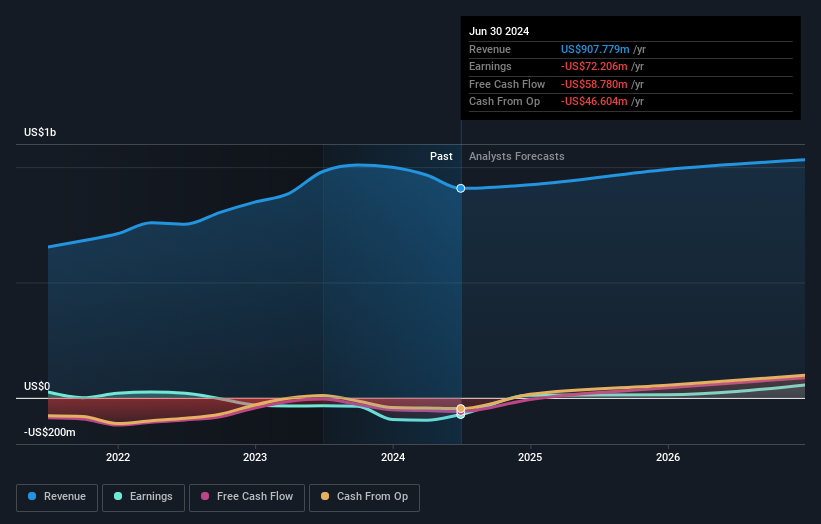- United States
- /
- Electrical
- /
- NYSE:BW
After losing 74% in the past year, Babcock & Wilcox Enterprises, Inc. (NYSE:BW) institutional owners must be relieved by the recent gain

Key Insights
- Given the large stake in the stock by institutions, Babcock & Wilcox Enterprises' stock price might be vulnerable to their trading decisions
- 51% of the business is held by the top 6 shareholders
- Using data from analyst forecasts alongside ownership research, one can better assess the future performance of a company
A look at the shareholders of Babcock & Wilcox Enterprises, Inc. (NYSE:BW) can tell us which group is most powerful. We can see that institutions own the lion's share in the company with 44% ownership. Put another way, the group faces the maximum upside potential (or downside risk).
After a year of 74% losses, last week’s 11% gain would be welcomed by institutional investors as a possible sign that returns might start trending higher.
Let's delve deeper into each type of owner of Babcock & Wilcox Enterprises, beginning with the chart below.
See our latest analysis for Babcock & Wilcox Enterprises

What Does The Institutional Ownership Tell Us About Babcock & Wilcox Enterprises?
Institutional investors commonly compare their own returns to the returns of a commonly followed index. So they generally do consider buying larger companies that are included in the relevant benchmark index.
Babcock & Wilcox Enterprises already has institutions on the share registry. Indeed, they own a respectable stake in the company. This implies the analysts working for those institutions have looked at the stock and they like it. But just like anyone else, they could be wrong. When multiple institutions own a stock, there's always a risk that they are in a 'crowded trade'. When such a trade goes wrong, multiple parties may compete to sell stock fast. This risk is higher in a company without a history of growth. You can see Babcock & Wilcox Enterprises' historic earnings and revenue below, but keep in mind there's always more to the story.

Hedge funds don't have many shares in Babcock & Wilcox Enterprises. B. Riley Financial, Inc. is currently the largest shareholder, with 30% of shares outstanding. With 6.6% and 4.6% of the shares outstanding respectively, Neuberger Berman Investment Advisers LLC and Castleknight Management LP are the second and third largest shareholders. In addition, we found that Kenneth Young, the CEO has 1.7% of the shares allocated to their name.
We did some more digging and found that 6 of the top shareholders account for roughly 51% of the register, implying that along with larger shareholders, there are a few smaller shareholders, thereby balancing out each others interests somewhat.
While it makes sense to study institutional ownership data for a company, it also makes sense to study analyst sentiments to know which way the wind is blowing. There are plenty of analysts covering the stock, so it might be worth seeing what they are forecasting, too.
Insider Ownership Of Babcock & Wilcox Enterprises
The definition of company insiders can be subjective and does vary between jurisdictions. Our data reflects individual insiders, capturing board members at the very least. The company management answer to the board and the latter should represent the interests of shareholders. Notably, sometimes top-level managers are on the board themselves.
I generally consider insider ownership to be a good thing. However, on some occasions it makes it more difficult for other shareholders to hold the board accountable for decisions.
We can see that insiders own shares in Babcock & Wilcox Enterprises, Inc.. In their own names, insiders own US$6.8m worth of stock in the US$116m company. It is good to see some investment by insiders, but we usually like to see higher insider holdings. It might be worth checking if those insiders have been buying.
General Public Ownership
The general public, who are usually individual investors, hold a 20% stake in Babcock & Wilcox Enterprises. While this group can't necessarily call the shots, it can certainly have a real influence on how the company is run.
Public Company Ownership
Public companies currently own 30% of Babcock & Wilcox Enterprises stock. It's hard to say for sure but this suggests they have entwined business interests. This might be a strategic stake, so it's worth watching this space for changes in ownership.
Next Steps:
While it is well worth considering the different groups that own a company, there are other factors that are even more important. Like risks, for instance. Every company has them, and we've spotted 3 warning signs for Babcock & Wilcox Enterprises (of which 1 makes us a bit uncomfortable!) you should know about.
If you would prefer discover what analysts are predicting in terms of future growth, do not miss this free report on analyst forecasts.
NB: Figures in this article are calculated using data from the last twelve months, which refer to the 12-month period ending on the last date of the month the financial statement is dated. This may not be consistent with full year annual report figures.
Valuation is complex, but we're here to simplify it.
Discover if Babcock & Wilcox Enterprises might be undervalued or overvalued with our detailed analysis, featuring fair value estimates, potential risks, dividends, insider trades, and its financial condition.
Access Free AnalysisHave feedback on this article? Concerned about the content? Get in touch with us directly. Alternatively, email editorial-team (at) simplywallst.com.
This article by Simply Wall St is general in nature. We provide commentary based on historical data and analyst forecasts only using an unbiased methodology and our articles are not intended to be financial advice. It does not constitute a recommendation to buy or sell any stock, and does not take account of your objectives, or your financial situation. We aim to bring you long-term focused analysis driven by fundamental data. Note that our analysis may not factor in the latest price-sensitive company announcements or qualitative material. Simply Wall St has no position in any stocks mentioned.
About NYSE:BW
Babcock & Wilcox Enterprises
Provides energy and emissions control solutions to industrial, electrical utility, municipal, and other customers worldwide.
Undervalued with moderate growth potential.

